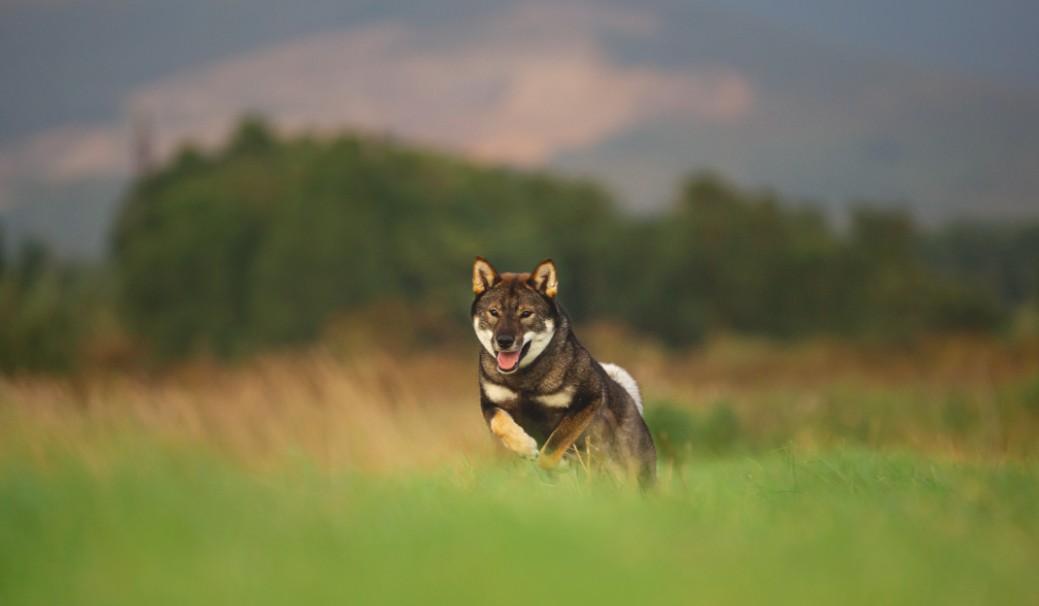Shikoku
Temperament: Gentle with his people, active and alert hunter, an ancient breed with endurance, energy and intelligence
Height: 17 to 22 inches
Weight: 35-55 lbs
Life Span: 10-12 years
Breed Average Outlier Index: 0.33
OI Average for dogs over 10: 0.33
OI Average for dogs under 2: 0.32
Breed Average Genetic Relatedness: 0.00
AGR Average for dogs over 10: -0.02
AGR Average for dogs under 2: 0.02
Breed Average Internal Relatedness: 0.00
IR Average for dogs over 10: 0.01
IR Average for dogs under 2: 0.01

Last 10 Recently Added Public Dogs!
| No. | Name | Gender | Outlier Index | Average Genetic Relatedness | Internal Relatedness | 1 | Kintaro Go Aoiyama Sou | M | 0.27 | -0.05 | 0.19 | 2 | Doruto Go Shibukawa Kato Kensha | M | 0.21 | 0.02 | -0.05 | 3 | Dostoyanie Tayokhary Benzaiten | F | 0.28 | -0.02 | 0.04 | 4 | Aki Akino Akai Bijo Kara | M | 0.17 | 0.08 | 0.17 | 5 | Aki Asahi Akai Bijo Kara | M | 0.24 | -0.01 | 0.24 | 6 | Aki Akito Akai Bijo Kara | M | 0.21 | 0.00 | 0.26 | 7 | Anzuhime go Yamamichisou | F | 0.27 | 0.03 | 0.05 | 8 | Hirokohime Go Hachidorisou | F | 0.41 | -0.07 | 0.03 | 9 | Fudzisan Haito Kon | F | 0.25 | 0.08 | -0.08 | 10 | Kusanagi | M | 0.41 | -0.21 | 0.23 |
|---|
This breed evolved in the mountainous Kochi region of Japan, hunting boar. They are tough and agile, adapted to the challenging terrain. They were designated a "national monument" of Japan in 1937.
Joint and hip issues, luxating patellae, entropian, epilepsy,
The follow includes dogs with birthdates listed in the database.
DLA Haplotypes in the Breed
The Dog Leukocyte Antigen or DLA is the region in the canine genome that controls the immune system, among other things. There are three classes or areas, and the VGL Canine Diversity Test genotypes or records the two regions with the most variation. Because it is an area that mutates more rapidly than others, the method VGL uses is ideal for identifying specific combinations of DNA, and not merely showing whether a dog inherited two of the same sets of genetics from its parents or two different ones.
"Haplotype" is a generic name for a set of genes that are bound together and inherited as a set. The DLA Class I and Class II haplotypes are very tightly bound and represent about 2 million base pairs of DNA - a sizeable chunk. These two haplotypes together make an extended haplotype that is nearly always passed from parent to puppies as a pair. We therefore have two tables below showing both the combinations of DLA found in this breed and how often they appear, and also how often they appear individually.
Remember that frequency percentages do not show how many dogs carry them, but rather how many of these haplotypes exist in the breed as a whole. Every dog has two sets of DLA haplotypes, one inherited from dam, and one inherited from sire. These almost never recombine in new generations.
DLA Class I/Class II Combinations :
| Class I Haplotype | Class II Haplotype | Frequency in the Breed | 1133 | 2077 | 54.00% | 1133 | 2077 | 54.00% | 1191 | 2018 | 17.60% | 1191 | 2018 | 17.60% | 1231 | 2122 | 10.40% | 1231 | 2122 | 10.40% | 1229 | 2056 | 6.40% | 1229 | 2056 | 6.40% | 1232 | 2012 | 3.20% | 1232 | 2012 | 3.20% | 1229 | 2123 | 2.80% | 1229 | 2123 | 2.80% | 1054 | 2106 | 1.60% | 1230 | 2071 | 1.60% | 1054 | 2106 | 1.60% | 1230 | 2071 | 1.60% | 1091 | 2067 | 0.80% | 1091 | 2067 | 0.80% |
|---|
DLA Frequencies :
| Class | Haplotype | Frequency in the Breed | Class I | 1054 | 1.63% | Class I | 1091 | 0.81% | Class I | 1133 | 54.88% | Class I | 1191 | 17.89% | Class I | 1229 | 9.35% | Class I | 1230 | 1.63% | Class I | 1231 | 10.57% | Class I | 1232 | 3.25% | Class II | 2012 | 3.25% | Class II | 2018 | 17.89% | Class II | 2056 | 6.50% | Class II | 2067 | 0.81% | Class II | 2071 | 1.63% | Class II | 2077 | 54.88% | Class II | 2106 | 1.63% | Class II | 2122 | 10.57% | Class II | 2123 | 2.85% | Class I | 1054 | 1.63% | Class I | 1091 | 0.81% | Class I | 1133 | 54.88% | Class I | 1191 | 17.89% | Class I | 1229 | 9.35% | Class I | 1230 | 1.63% | Class I | 1231 | 10.57% | Class I | 1232 | 3.25% | Class II | 2012 | 3.25% | Class II | 2018 | 17.89% | Class II | 2056 | 6.50% | Class II | 2067 | 0.81% | Class II | 2071 | 1.63% | Class II | 2077 | 54.88% | Class II | 2106 | 1.63% | Class II | 2122 | 10.57% | Class II | 2123 | 2.85% |
|---|
Search For a Shikoku
Please enter a name or partial name of a public dog.
List of Public Dogs
Warning: Undefined variable $breeder_list in /usr/local/www/wp-content/plugins/xyz-wp-insert-code-snippet/shortcode-handler.php(225) : eval()'d code on line 724
Breeder list coming soon.